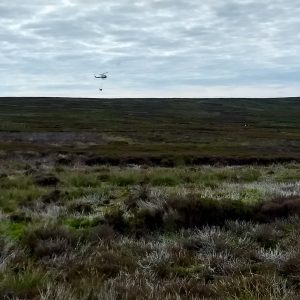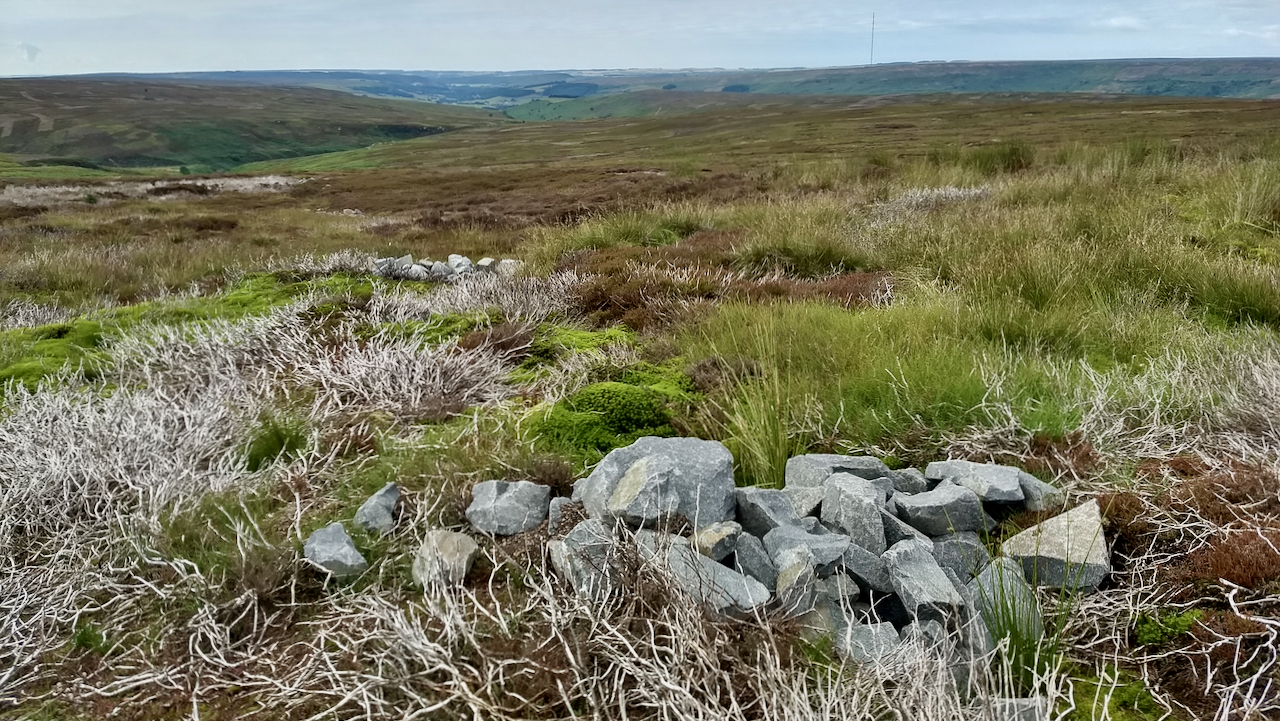Whenever I hear the dull throb of a helicopter I am reminded of the 1970s American T.V. comedy series ‘M.A.S.H.’
I can’t get that theme tune out of my head now.
Last Thursday, whilst working with the National Trust in Bransdale, a helicopter had been operating from Bransdale Ridge. It was busy all day ferrying what I thought were bags of stone to somewhere south-east. I had assumed the stone was for path restoration and I had struggled to think of a popular path in that direction.

Then today, crossing Urra Moor, that familiar throb. The chopper was coming straight towards me. Do the gamekeepers have a new trick up their sleeves, strafing runners off their land?
It dropped down behind a ridge. My curiosity was piqued. I had to have a look.
The answer was that contractors were busy blocking up grips or ditches in an attempt to restore the bogs on the moors.
I have previously come across this technique before using wood dams in the Pennines, and here on Urra Moor, using bales of straw or heather. Stone is used when the grips have eroded down to the underlying subsoil. Apparently it’s not the case of just dumping a pile of rock in the grip. The contractors will have to hand move the stones to ensure the optimum shape and the grip sides will need re-profiling to approximately a 33° slope1Yorkshire Peat Partnership Technical Specification 1 Gully & Grip Blocking or Sediment Trapping techniques. (n.d.). [online] . Available at: https://www.yppartnership.org.uk/sites/default/files/2018-07/171011%20Technical%20Specification%201%20Blocking%20and%20sediment%20trapping%20in%20gullies%20and%20grips%20%20TT.doc.pdf.. No doubt a digger will be used for that.
I am guessing but this work is probably part of the 20-year plan to create the ‘Great North Bog‘ which includes the Peak District, Yorkshire Dales, the Lake District and Northumberland. 2,700 square miles of of peat moorland will be restored or protected. The cost is estimated to be over £200m.
Our peatlands are a gigantic store of carbon, locking up an estimated 400m tonnes, of which 3.7m tonnes is released annually due to erosion and desiccation. As our total carbon emissions are 350m tonnes per year, this represents a little over 1% of our emissions. This may seem small but reducing it will contribute us in achieving our carbon targets2Jobson, B. (2021). Ambitious plans aim to create a “Great North Bog.” [online] The Northern Farmer. Available at: https://www.northernfarmer.co.uk/news/19220930.ambitious-plans-aim-create-great-north-bog/ [Accessed 2 Aug. 2021].. Every little helps.
When peat soils dry out, erosion becomes more pronounced, getting washed downstream and giving the water the familiar brown colour. In water treatment plants, this colour can be removed by adding chlorine but this in turn generates carcinogens, which are costly to remove.
The practice of draining our uplands began with the Victorians but increased rapidly after the Second World War when the War Agricultural Executive Committee, set up to improve the productivity of farms, paid landowners to drain moorland bogs for sheep grazing.
Restoration of our peat lands will help reduce flood and fire risks, ease water treatment, and increase biodiversity. With the UK set to host the UN’s COP26 climate summit in Cornwall in November, this particular environmental project will certainly be one of the Government’s pet selling points.
- 1Yorkshire Peat Partnership Technical Specification 1 Gully & Grip Blocking or Sediment Trapping techniques. (n.d.). [online] . Available at: https://www.yppartnership.org.uk/sites/default/files/2018-07/171011%20Technical%20Specification%201%20Blocking%20and%20sediment%20trapping%20in%20gullies%20and%20grips%20%20TT.doc.pdf.
- 2Jobson, B. (2021). Ambitious plans aim to create a “Great North Bog.” [online] The Northern Farmer. Available at: https://www.northernfarmer.co.uk/news/19220930.ambitious-plans-aim-create-great-north-bog/ [Accessed 2 Aug. 2021].

Leave a Reply to John Cancel reply